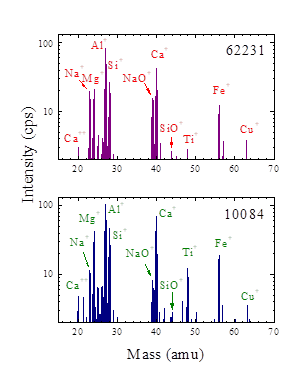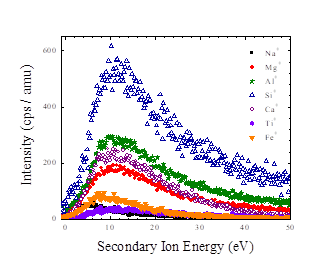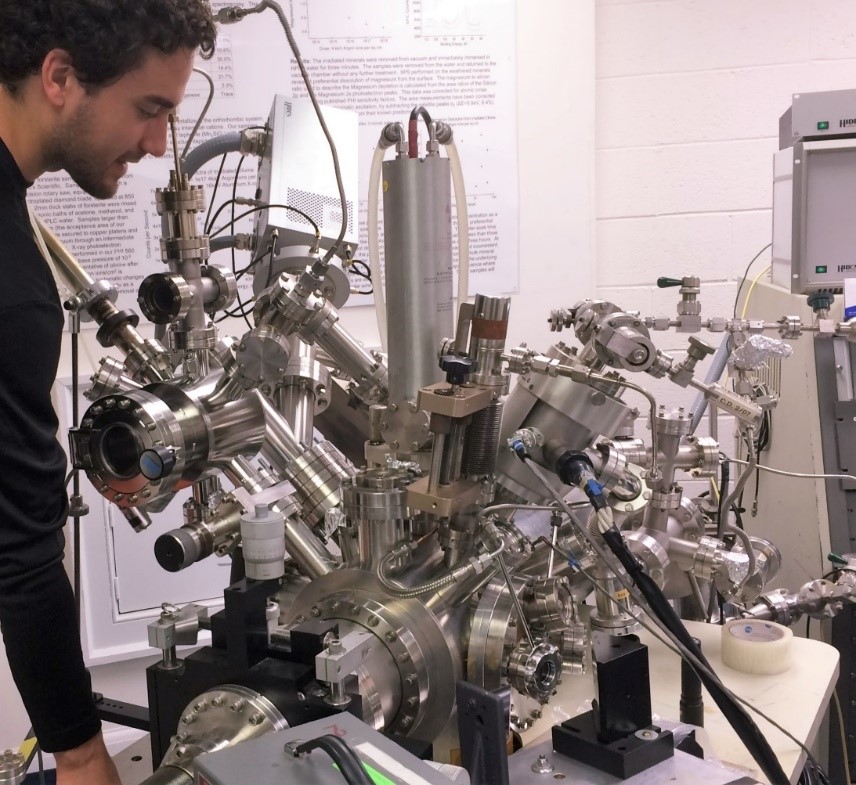Bounded by the emptiness of space and the Moon’s surface, the lunar exosphere is an atmosphere so thin that atoms rarely collide. This environment, composed primarily of neutral atoms and molecules, is generated by the interaction of radiation from the sun, meteoritic bombardment and radioactive decay, balanced by losses into space and recycling back to the surface. Sputtering by solar H+ and He++ ejects lunar material into the exosphere at low energies; a fraction of which are ionized species. Sputtered secondary ions carry direct information about the planetary surface composition and are easily observed by spacecraft ion mass spectrometers. Measurements from the AMPTE, LADEE, WIND, and SELENE missions to the Moon have identified photo-ionized neutrals and secondary ions in the exosphere, including: H2+, He+, C+, O+, Na+, Al+, Si+, CO+, K+, Ar+, Ca+, and Fe+ [Hilchenbach et al. 1993; Stern 1999; Yakota et al. 2009, 2014; Halekas, J. S., et al. 2015].
To better understand the relationship between solar-wind derived secondary ions and the lunar surface composition, as well as guide the design of spacecraft mass spectrometers, secondary ion mass spectra (Fig. 1) were obtained during 4 keV He+ irradiation of lunar soils returned by the Apollo missions. For lunar analogs, we use < 1mm grains of two mature soil samples, mare 10084 and highland 62231, as well as a Corning glass lunar-simulant and the silicate-mineral olivine. Our sample surface compositions were measured by X-ray photoelectron spectroscopy (XPS) and SIMS spectra were taken with a Hiden Analytical EQS. For this study, positive SIMS spectra were measured at ejected ion energies from 2 to 36 eV, a range where the instrument transmission is expected to be roughly constant as a function of energy. The extraction lens voltages were optimized for ions of mass 27 (Al+) before collecting spectra. Because the lunar soils charged significantly under ion bombardment, the sample surface was charge neutralized during SIMS data collection using low energy (≤ 4 eV) electrons.

Figure 1. Secondary ion mass spectra of mature, lunar mare soil 10084 and highland soil 62231 for 10 eV ions ejected from the surface by 4 keV He+. Cu+ is an impurity and not intrinsic to the sample
Sputtered secondary ion intensities do not share a 1-to-1 correspondence with the surface composition, but are dependent on primary ion type, atom ionization potential, and the local composition of the solid matrix. Thus, care should be taken to determine yields on calibration standards of known composition that closely match the target of interest. Species-dependent relative yield factors were determined to correlate the secondary-ion count rates with the atomic surface composition. The correction factors can be used together with Monte Carlo simulations of solar wind bombardment to predict the sputtered ion spectra for asteroids, planetary satellites, and other airless bodies [Schaible et al., in prep.]. Furthermore, we observe that SIMS spectra change with fluence, reaching equilibrium only after ~4 x 1017 He+ cm-2 (roughly 9000 years on the lunar surface). Our spectra show that ion irradiation preferentially removes weakly bound species such as Na and O, enriching the surface in the more refractory materials: Mg, Al, Ca, Ti, and Fe. Secondary ion energy spectra were also collected for selected masses (Fig 2). It is seen that the distributions all rise rapidly, peak below 15 eV, and then drop off slowly with energy, typical of insulating surfaces.

Figure 2. Energy spectra of secondary ion ejected from mature lunar mare soil 10084 by 4 keV He+.
This study demonstrates that appreciable numbers of secondary ions ejected by solar wind type ions from lunar soils can be measured in minutes in the laboratory, and these measurements can help guide the exploration of the Moon and infer the surface composition of other airless planetary bodies exposed to solar-wind, magnetospheric, or ionospheric ions.

Figure 3. Experimental setup with Hiden Analytical EQS secondary ion mass spectrometer on a modified PHI 560 XPS/SAM system.
Paper Reference: C. A. Dukes & R. A. Baragiola (2015) “The lunar surface-exosphere connection: Measurement of secondary-ions from Apollo soils” Icarus 255, 51-57 https://doi.org/10.1016/j.icarus.2014.11.032
Download Project Summary: AP1060
Project summary by: A. Dukes and M. J. Schaible, University of Virginia, Laboratory for Atomic and Surface Physics, Charlottesville, VA 22904 USA
To find out more about this product visit the EQS product page or if you would like to contact us directly please Send us a Message.

